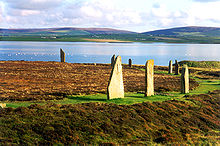- Ness of Brodgar
-
Ness of Brodgar is an archaeological site covering 2.5 hectares (6.2 acres) excavated from 2003 onwards between the Ring of Brodgar and the Stones of Stenness in the Heart of Neolithic Orkney World Heritage Site near Loch of Harray, Orkney, in Scotland. It has provided evidence of housing, decorated stone slabs, a massive stone wall with foundations, and a large building described as a Neolithic "cathedral"[1] or "palace".[2] The site may have been occupied from as early as 3500 BC to the close of the Neolithic period more than a millennium and a half later.[1][3]
According to project manager Nick Card, the discoveries are unparalleled in British prehistory, the complexity of finds is changing the "whole vision of what the landscape was 5,000 years ago" and that "it’s of a scale that almost relates to the classical period in the Mediterranean with walled enclosure and walled precincts".[2]
Finds
Excavations have revealed several buildings, both ritual and domestic and the works suggest there are likely to be more in the vicinity. Pottery, cremated animal bones, stone tools and polished stone mace heads have also been discovered.[4][5] Some of the stone slabs are decorated with geometrical lozenges typical of other Neolithic sites.[3]
There are the remains of a large stone wall (the "Great Wall of Brodgar") which may have been 100 metres (330 ft) long and 4 metres (13 ft) or more wide. It appears to traverse the entire peninsula the site is on and may have been a symbolic barrier between the ritual landscape of the Ring and the mundane world around it.[3][6]
The temple-like structure, which was discovered in 2008, has walls 4 metres (13 ft) thick and the shape and size of the building are visible, with the walls still standing to a height of more 1 metre (3.3 ft). The structure is 25 metres (82 ft) long and 20 metres (66 ft) wide and a standing stone with a hole shaped like an hourglass was incorporated into the walls. There is a cross-shaped inner sanctum and the building was surrounded by a paved outer passage. The archaeological team believe it is the largest structure of its kind anywhere in the north of Britain and that it would have dominated the ritual landscape of the peninsula. Recent finds include Skaill knives[7] and hammer stones and the another, perhaps even bigger wall. The dig involves archaeologists from Orkney College and from the universities of Aberdeen, Cardiff and Glasgow.[1][8][9][10]
In July 2010 a remarkable rock coloured red, orange and yellow was unearthed. This is the first discovery in Britain of evidence that Neolithic peoples used paint to decorate their buildings and is similarly coloured to the natural shades of sandstone used in the construction of the inner sanctum.[11] It is thought that the primitive paint could have been made from iron ore, mixed with animal fat, milk or eggs.[12] Only a week later a stone with a zigzag chevron pattern painted with a red pigment was discovered nearby.[13]
A 30mm high figurine with a head, body and two eyes, similar to the Westray Wife called the "Brodgar Boy" was also unearthed in the rubble of one of the structures.[14]
References
- ^ a b c Ross, John and Hartley, David (14 August 2009) " 'Cathedral' as old as Stonehenge unearthed." Edinburgh. The Scotsman. Retrieved 16 August 2009.
- ^ a b Turnbull, Catherine (27 August 2011). "Ness of Brodgar discoveries ‘rival classical Greece’". The Times Scotland (London). http://www.thetimes.co.uk/tto/news/uk/scotland/article3147162.ece. Retrieved 27 August 2011.
- ^ a b c Towrie, Sigurd (16 August 2007) "Stone wall hints at Neolithic spiritual barrier " Orkneyjar. Retrieved 17 September 2008.
- ^ "Ness of Brodgar, Stenness, Mainland, Orkney" UHI: Orkney College. Retrieved 30 August 2008.
- ^ "Orkney Archaeology News" Orkneyjar. Retrieved 30 August 2008.
- ^ Ross, John (14 August 2007) "Experts uncover Orkney's new Skara Brae and the great wall that separated living from dead". Edinburgh. The Scotsman. Retrieved 16 August 2009.
- ^ A flaked stone with a sharp edge used for cutting. This neolithic tool is named after Skaill Bay, the location of World Heritage Site Skara Brae in Orkney. See "Skaill knife" (pdf) Historic Scotland. Retrieved 21 March 2007.
- ^ "Neolithic ‘temple’ revealed at site on Orkney" Glasgow. The Herald. Retrieved 16 August 2009.
- ^ Macintosh, Lindsay (14 August 2009) " 'Neolithic cathedral built to amaze’ unearthed in Orkney dig" London. The Times. Retrieved 16 August 2009.
- ^ "The Ness of Brodgar Excavations". (14 August 2009) Orkneyjar. Retrieved 16 August 2009.
- ^ "Rock shows Stone Age Scots keen decorators" (28 July 2010) Glasgow: The Herald.
- ^ "Painted walls in Orkney '5,000 years old'". BBC News. 26 July 2010. http://www.bbc.co.uk/news/uk-scotland-north-east-orkney-shetland-10763044. Retrieved 2010-07-28.
- ^ "Decorated Neolithic stonework found on Orkney". (4.8.10) Glasgow: The Herald.
- ^ "Brodgar Boy" Orkneyjar. Retrieved 28 Aug 2011.
External links
Prehistoric Orkney World Heritage Site Other Neolithic Sites Barnhouse Settlement · Blackhammer Chambered Cairn · Castle Bloody · Dwarfie Stane · Holm of Papa Westray · Knap of Howar · Links of Noltland · Midhowe Chambered Cairn · Mor Stein · Rinyo · Rousay · Tomb of the Eagles · Unstan Chambered Cairn · Unstan ware · Westray WifeIron Age Sites Categories:- 4th-millennium BC architecture
- Archaeological sites in Orkney
- Prehistoric Orkney
- Stone Age sites in Scotland
- Former populated places in Scotland
- Neolithic sites
- Neolithic settlements
- Neolithic Scotland
Wikimedia Foundation. 2010.


